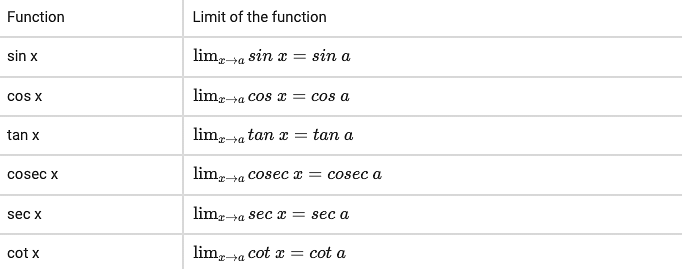The value of $\frac{\log_{3} 5 \times \log_{25} 27 \times \log_{49} 7}{\log_{81} 3}$ is
- 1
- 6
- $\frac{2}{3}$
- 3
The Correct Option is D
Solution and Explanation
$=3\left[\because \log _{a} b=\frac{\log b}{\log a}\right]$
Top Questions on limits of trigonometric functions
- The value of \( \lim_{x \to 0} \left( \frac{\tan 11x}{\tan 5x} \right) \) is:
- GATE MN - 2025
- Engineering Mathematics
- limits of trigonometric functions
- Find the value of the following expression: \[ \tan^2(\sec^{-1}4) + \cot(\csc^{-1}3) \]
- MHT CET - 2025
- Mathematics
- limits of trigonometric functions
- Given a real-valued function \( f \) such that: \[ f(x) = \begin{cases} \frac{\tan^2\{x\}}{x^2 - \lfloor x \rfloor^2}, & \text{for } x > 0 \\ 1, & \text{for } x = 0 \\ \sqrt{\{x\} \cot\{x\}}, & \text{for } x < 0 \end{cases} \] Then:
- BITSAT - 2024
- Mathematics
- limits of trigonometric functions
- Evaluate the limit: \[ \lim_{\theta \to \frac{\pi}{2}} \frac{8\tan^4\theta + 4\tan^2\theta + 5}{(3 - 2\tan\theta)^4} \]
- TS EAMCET - 2024
- Mathematics
- limits of trigonometric functions
- If \( f(x) \) is defined as follows:
\[ f(x) = \begin{cases} \frac{x - \lfloor x \rfloor}{x - 2} & \text{if } x = 2 \\ \frac{|x - \lfloor x \rfloor|}{a^2 + (x - \lfloor x \rfloor)^2} & \text{if } 1 < x < 2 \\ 2a - b & \text{if } x = 1 \end{cases} \]
Then the limit \( \displaystyle \lim_{x \to 0} \frac{\sin(ax) + x \tan(bx)}{x^2} \) is:- AP EAPCET - 2023
- Mathematics
- limits of trigonometric functions
Questions Asked in WBJEE exam
- Ruma reached the metro station and found that the escalator was not working. She walked up the stationary escalator with velocity \( v_1 \) in time \( t_1 \). On another day, if she remains stationary on the escalator moving with velocity \( v_2 \), the escalator takes her up in time \( t_2 \). The time taken by her to walk up with velocity \( v_1 \) on the moving escalator will be:
- WBJEE - 2025
- Relative Motion
A quantity \( X \) is given by: \[ X = \frac{\epsilon_0 L \Delta V}{\Delta t} \] where:
- \( \epsilon_0 \) is the permittivity of free space,
- \( L \) is the length,
- \( \Delta V \) is the potential difference,
- \( \Delta t \) is the time interval.
The dimension of \( X \) is the same as that of:- WBJEE - 2025
- Dimensional Analysis
- Which logic gate is represented by the following combination of logic gates?

- WBJEE - 2025
- Logic gates
- The variation of displacement with time of a simple harmonic motion (SHM) for a particle of mass \( m \) is represented by: \[ y = 2 \sin \left( \frac{\pi}{2} + \phi \right) \, \text{cm} \] The maximum acceleration of the particle is:
- WBJEE - 2025
- simple harmonic motion
- A force \( \mathbf{F} = ai + bj + ck \) is acting on a body of mass \( m \). The body was initially at rest at the origin. The co-ordinates of the body after time \( t \) will be:
- WBJEE - 2025
- Newtons Laws of Motion
Concepts Used:
Limits of Trigonometric Functions
Assume a is any number in the general domain of the corresponding trigonometric function, then we can explain the following limits.

We know that the graphs of the functions y = sin x and y = cos x detain distinct values between -1 and 1 as represented in the above figure. Thus, the function is swinging between the values, so it will be impossible for us to obtain the limit of y = sin x and y = cos x as x tends to ±∞. Hence, the limits of all six trigonometric functions when x tends to ±∞ are tabulated below:
